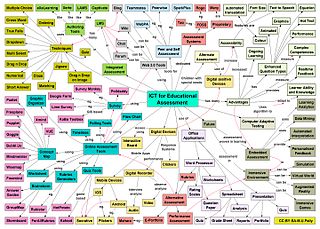Related Research Articles
E-government is the use of technological communications devices, such as computers and the Internet, to provide public services to citizens and other persons in a country or region. E-government offers new opportunities for more direct and convenient citizen access to government, and for government provision of services directly to citizens.
E-services are services which use of information and communication technologies (ICTs). The three main components of e-services are- service provider, service receiver and the channels of service delivery. For example, as concerned to public e-service, public agencies are the service provider and citizens as well as businesses are the service receiver. The channel of service delivery is the third requirement of e-service. Internet is the main channel of e-service delivery while other classic channels are also considered.

Information and communications technology (ICT) is an extensional term for information technology (IT) that stresses the role of unified communications and the integration of telecommunications and computers, as well as necessary enterprise software, middleware, storage and audiovisual, that enable users to access, store, transmit, and manipulate information.

Northgate Public Services (Northgate) is a provider of specialist software and outsourcing services for the public sector and is based in the United Kingdom.
Information and communication technology in agriculture, also known as e-agriculture, focuses on the enhancement of agricultural and rural development through improved information and communication processes. More specifically, e-agriculture involves the conceptualization, design, development, evaluation and application of innovative ways to use information and communication technologies (ICTs) in the rural domain, with a primary focus on agriculture. ICT includes devices, networks, mobiles, services and applications; these range from innovative Internet-era technologies and sensors to other pre-existing aids such as fixed telephones, televisions, radios and satellites. Provisions of standards, norms, methodologies, and tools as well as development of individual and institutional capacities, and policy support are all key components of e-agriculture.
Participatory Web 2.0 for development in short Web2forDev is a way of employing web services, in order to improve information sharing and collaborative production of content in the context of development work. In this context actors in development can easily relate to other stakeholders, have selective access to information, produce and publish their own content and redistribute pieces of content released by others. They can integrate, combine, aggregate, generate, moderate and mediate content. In a typical Web2forDev scenario data and/or functionalities from a number of free/low cost online applications are combined and served as mashups thus ensuring a wide range of online services at low cost.
Market information systems are information systems used in gathering, analyzing and disseminating information about prices and other information relevant to farmers, animal rearers, traders, processors and others involved in handling agricultural products. Market information systems play an important role in agro-industrialisation and food supply chains. With the advance of information and communication technologies for development (ICTs) in developing countries, the income- generation opportunities offered by market information systems have been sought by international development organizations, non-governmental organizations (NGOs) and businesses alike.
AGRIS is a global public domain database with more than 12 million structured bibliographical records on agricultural science and technology. It became operational in 1975 and the database was maintained by Coherence in Information for Agricultural Research for Development, and its content is provided by more than 150 participating institutions from 65 countries. The AGRIS Search system, allows scientists, researchers and students to perform sophisticated searches using keywords from the AGROVOC thesaurus, specific journal titles or names of countries, institutions, and authors.
Nano Ganesh is an irrigation automation system from Indian company which allows farmers to use mobile phones to remotely control the irrigation pumps located in distant hazardous locations. It is a hardware device attached to the existing starter and water pump set. The application was developed by Ossian Agro Automation in Pune, India, initially with external basic mobile phones used for wireless connectivity and later on with built-in GSM modules named as Nano Ganesh GSM. The overall developments of various wireless remote controllers began in 1996 by Santosh Ostwal, an Electrical Engineer, the founder of Ossian and son of a farmer. Approximately 60,000 farmers in India have been using Nano Ganesh since 2008 till 2017. In mid-2009, it was tested in Anand district in the Indian state of Gujarat in partnership with Tata Teleservices using Tata phones. Later, it was designed to operate on any basic mobile phones. In 2014, Ossian further upgraded the technology as Nano Ganesh M2M to monitor the water level of overhead water tanks on mobile phones and remotely control the water pump as per the lower and overflow levels of water in the tanks.
Almost All Questions Answered or aAQUA is a Farmer Knowledge Exchange available at aaqua.org answering questions from progressive farmers in 4 languages in any one of 420 districts in India and some places abroad.

The GSM Association is an industry organisation that represents the interests of mobile network operators worldwide. More than 750 mobile operators are full GSMA members and a further 400 companies in the broader mobile ecosystem are associate members. The GSMA represents its members via industry programmes, working groups and industry advocacy initiatives.
Eurotech is a company dedicated to the research, development, production and marketing of miniature computers (NanoPCs) and high performance computers (HPCs).
RML AgTech Pvt. Ltd., formerly known as Reuters Market Light is a business to provide Technology & Data Analytics Solutions to farmers and the agriculture value chain.
The United Arab Emirates (UAE) once largely known for its oil exports today has a diverse and highly developed economy. According to the UAE Economic Report 2009 released by the UAE Ministry of Economy in May 2010 the non-oil sector contributed 71.6 per cent to the UAE’s GDP, compared to 66.5 per cent in 2008, underscoring the success of the nation's economic diversification initiatives.

The Telecommunications Software & Systems Group (TSSG) is a large Irish information and communications technologies (ICT) research institute in Waterford Institute of Technology. It is based in the WIT West Campus, having brought in the funding for the two research buildings located there: ArcLabs Research and Innovation Centre, combining the TSSG with incubation and innovation space, formally opened by the Taoiseach in October 2006, and NetLabs, formally opened by Minister of Education in March 2014.
Information and communication technology (ICT) in Kosovo has experienced a remarkable development since 1999. From being almost non-existent 10 years ago, Kosovar companies in the information technology (IT) domain offer today wide range of ICT services to their customers both local as well as to foreign companies. Kosovo has the youngest population in Europe, with advanced knowledge in ICT.

Ghana Open Data Initiative (GODI) was started in January 2012 by the National Information Technology Agency (NITA) in partnership with the Web Foundation (WF), to make Government of Ghana data available to the public for re-use. The establishment of GODI is meant to promote efficiency, transparency and accountability in governance as well as to facilitate economic growth by means of the creation of Mobile and Web applications for the Ghanaian and world markets. The project was scheduled for completion in 2014 and aimed to create a sustainable Open Data ecosystem for Ghana. GODI was launched with a 100 data sets categorized as political, legal, organizational, technical, social or economic. The vision of GODI is to develop an open data community involving the Government of Ghana, civil society organizations, industry, developer communities, academia, media practitioners, and the citizenry, to interact with one another with the aim of developing an open data portal to bring about transparency, accountability and efficiency in government.
The agricultural value chain concept has been used since the beginning of the millennium, primarily by those working in agricultural development in developing countries. Although there is no universally accepted definition of the term, it normally refers to the whole range of goods and services necessary for an agricultural product to move from the farm to the final customer or consumer.
Digital agriculture refers to tools that digitally collect, store, analyze, and share electronic data and/or information along the agricultural value chain. Other definitions, such as those from the United Nations Project Breakthrough, Cornell University, and Purdue University, also emphasize the role of digital technology in the optimization of food systems.
References
- ↑ "Archived copy". Archived from the original on 2012-11-02. Retrieved 2012-12-10.CS1 maint: archived copy as title (link)
- ↑ Mobile Applications in Agriculture, http://www.syngentafoundation.org/__temp/Report_on_mAgriculture_abridged_web_version.pdf Archived 2015-02-18 at the Wayback Machine
- ↑ Mobile Development Impact Agriculture Sector, http://www.m4dimpact.com/data/sectors/mobile-agriculture
- ↑ Mobile Applications in Agriculture (2011) Syngenta Foundation http://www.syngentafoundation.org/__temp/Report_on_mAgriculture_abridged_web_version.pdf Archived 2015-02-18 at the Wayback Machine
- ↑ Connected Agriculture: The role of mobile in driving efficiency and sustainability (2011) http://www.e-agriculture.org/content/connected-agriculture-role-mobile-driving-efficiency-and-sustainability Archived 2017-07-15 at the Wayback Machine